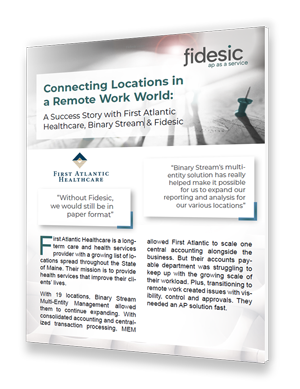Addressing Long-Term Care Staffing Issues | Where Automation Fits In
Long-term care organizations face a ton of challenges when it comes to staffing. High staff turnover and difficulty attracting qualified staff are key factors in recent staffing challenges.
In this article, we will explore long-term care staffing issues from the perspective of nursing homes and discuss how back office automation can help ease some of their challenges.
The COVID-19 pandemic caused many long-term care staffing issues to become more acute, with almost 400,000 long-term care staff members resigning in the first year of the pandemic, according to the Wall Street Journal. One 2022 NPR story said “The pandemic pummeled long-term care.”
A recent study from the American Healthcare Association (AHCA) and National Center for Assisted Living (NCAL) showed that long-term care organizations saw costs increase 41% over the course of 2021 while at the same time losing revenue as 61% were forced to limit admissions due to staffing shortages.
“The survey shows the severe and persistent workforce shortage nursing home providers have been facing, with too many facilities still struggling to hire and retain staff despite making every effort,” said president and CEO of AHCA Mark Parkinson in a statement.
These problems continue to plague the industry in 2023.
LTC operator First-Atlantic was able to streamline its accounting department across a growing number of locations. Read the Story
High Staffing Turnover
As stated above, one of the main challenges to staffing in long-term care facilities is high staff turnover. The average nursing home turns over more than half of its staff every single year, according to the Long-Term Care Community Coalition. This includes registered nursing staff.
The top causes behind high staffing turnover include new staff who do not intend to stay in their position long-term, staff burning out more often and a lack of overall job satisfaction.
Not only is routinely onboarding and training new staff members costly and time consuming, it can also lead to a lack of continuity of care for residents as new staff members may not be as familiar with their needs and preferences.
Attracting and Retaining Talent
According to AHCA, 71% percent of survey respondents said the lack of interested or qualified candidates is their top obstacle improving staffing shortages.
“Most nursing homes have few levers to pull to raise pay or improve the appeal of the job,” said David Grabowski, a professor of healthcare policy at Harvard Medical School, as quoted by the Wall Street Journal. “Some 80% to 85% of their revenue comes from Medicaid and Medicare, so their income is largely dependent on reimbursement rates set by those programs. Medicare typically covers limited-period stays for beneficiaries, while Medicaid is the source of funding for many long-term residents. Hospitals, by contrast, receive a large share of their revenue from commercial insurance.”
Adding fuel to the flame, many nursing homes are located in rural or underserved areas, which can make it difficult to attract staff members. Additionally, the demanding nature of the work, coupled with necessarily low wages and limited benefits, can make it difficult to retain staff members.
“As a provider that uniquely relies on government funding, policymakers must help nursing homes better compete for nurses and nurse aides,” said Parkinson with the AHCA, “As well as build up the pipeline to incentivize more people to pursue a career in long-term care.”
Where Does Automation Fit?
Back office automation is one lever that can be pulled to alleviate long-term care staffing shortages.
Automation software like accounting, payroll, employee training and bill pay can streamline processes and make the work environment more efficient and attractive to administrative staff. This can help free up time for all staff members to focus on providing care to residents, and can make the work environment more appealing to potential employees.
Back office automation like accounts payable software can reduce the need to hire clerks. Accounts payable clerking is a job field that is seeing similar staffing shortages in every industry, not just long-term care. By eliminating a need for a largely unwanted job position, accounts payable automation could potentially enable long-term care companies to increase the hiring wage of clinical staff to attract more candidates and provide higher levels of care for residents.
Automation will also help reduce the burden on nursing home administrators, who can then focus on other important tasks, such as attracting and retaining qualified staff.
Conclusion
The issue of long-term care staffing is a complex and multifaceted problem that affects nursing homes throughout the United States, Canada, and abroad. By implementing automation to improve back office efficiency, nursing homes can help ease some of the challenges they face and focus more resources on providing care to residents.
See how one multi-location LTC Operator Streamlined and Grew with Automation





